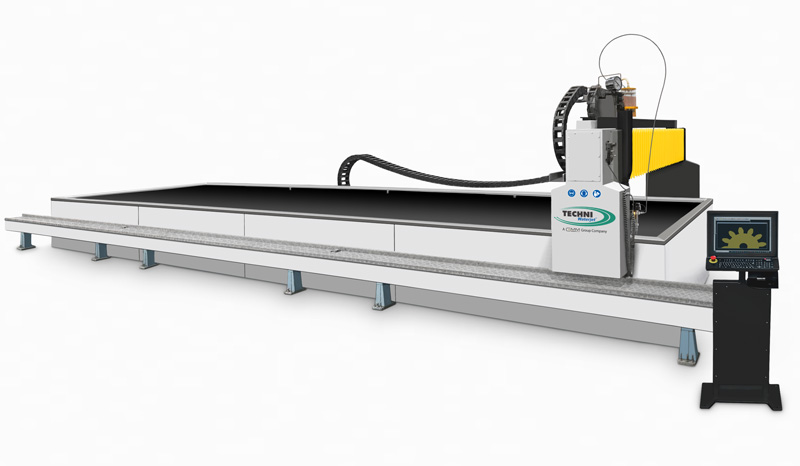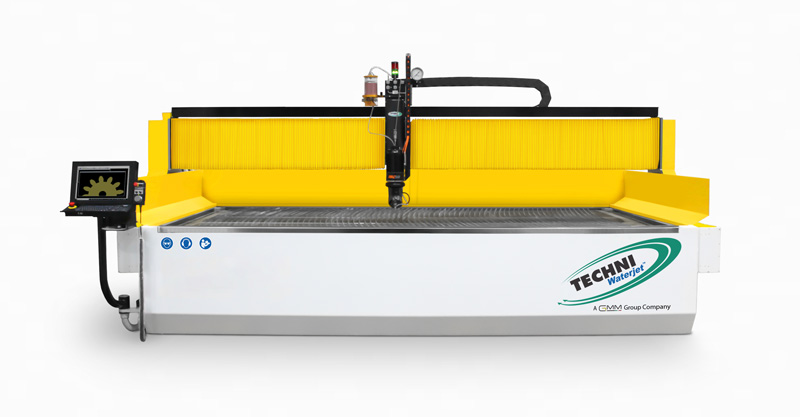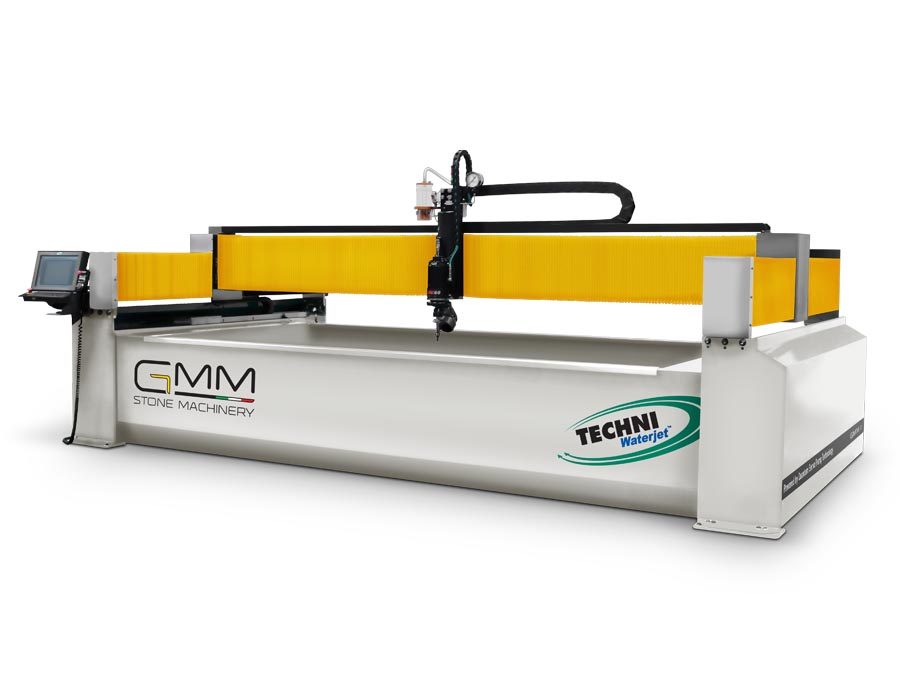Image Provided by Techni Waterjet
How Does Waterjet Cutting Enhance Productivity In Manufacturing?
Optimizing production processes is essential for organizations to stay competitive in the fast-paced manufacturing environment nowadays. Waterjet cutting is one technological advancement that has seen a lot of attention recently. The manufacturing sector is revolutionized by this ground-breaking technique, which uses the strength of water combined with abrasives to precisely cut a variety of materials. We will look at how waterjet cutting increases manufacturing productivity through its adaptability, accuracy, and environmental friendliness in this article.
Versatility:
Wide Material Compatibility:
One of the most appealing features of this technology is the variety of materials that may be cut using a waterjet cutter. A waterjet cutting machine can cut materials with varying strengths, durability, corrosion resistance, and conductivity, such as:
Waterjet cutters can cut any metal, including hardened tool steel, aluminum, titanium, carbon steel, stainless steel, and red metals (copper, brass, and bronze).
Natural Materials – Waterjet cutting machines employ specific techniques such as low-pressure piercing, water-only cutting, and vacuum assistance to cut a variety of natural materials such as glass, stone, wood, leather, and ceramics.
Plastics and Rubber – Waterjet cutting enables for the efficient and accurate cutting of plastic and rubber materials such as foam, rubber, linoleum, Plexiglas, polycarbonates, and acrylic. By adopting the cold cutting process of a waterjet cutter, businesses may avoid the material distortion barrier that is frequently faced when milling plastic on traditional Computer Numerical Control (CNC) equipment.

Image Provided by Techni Waterjet
Complex Shapes with Ease:
Complex shapes and detailed designs are frequently difficult to cut using traditional methods. Waterjet cutting’s outstanding precision in navigating difficult patterns enables producers to produce complex parts without compromising accuracy or productivity.Manufacturers can produce complex parts with no loss of accuracy or efficiency due to waterjet cutting’s outstanding precision in navigating intricate patterns.
Minimal Material Waste:
The preciseness of waterjet cutting decreases material waste by securely nesting pieces, maximizing the use of raw resources, and lowering production costs.
Precision:
Accuracy close to the micron:
Waterjet cutting is extremely precise, with tolerances as close as +/- 0.1 mm. By ensuring consistency in product quality, this accuracy minimizes the need for manual modifications and rework.
There is no heat generated during the cutting process.
Another distinct feature of the water jet is the ability to cut pieces without generating heat. This offers several advantages in terms of material selection and subsequent processes.
In many cases, heat can cause problems in the machining process. Too much heat while cutting softer materials may result in melting, warping, discoloration, and other unpleasant side effects that will harm the completed product. On tougher materials, adding heat actually changes the physical make-up of the plate/stock, making subsequent operations significantly more difficult.
Productivity Enhancement:
Rapid Prototyping:
Waterjet cutting facilitates rapid prototyping by quickly converting computer designs into actual prototypes. This speed allows for iterative testing and design refinement, which speeds up the product development cycle.
Shorter Lead Times:
Waterjet cutting’s adaptability allows manufacturers to move between different materials and designs with minimal setup time. This adaptability shortens lead times, allowing organizations to respond to changing market demands more quickly.

Image Provided by Techni Waterjet
Multi-Stack Cutting:
Waterjet systems may do multi-stack cutting, slicing many layers of material at the same time. This feature speeds up production by minimizing the number of passes required to reach the desired depth.
Minimal Post-Processing:
Waterjet cutting’s precision frequently removes the need for extensive post-processing, such as deburring or finishing. This efficiency minimizes labor-intensive processes while also speeding up product delivery.
Eco-Friendliness:
Waterjet cutting is an environmentally friendly cutting technology since it creates less heat and produces no toxic fumes or pollutants. This feature encourages a safer and healthier working environment for operators.
Reduced Material Waste:
Waterjet cutting precision lowers scrap and material waste, so contributing to resource conservation and sustainability.
Minimal Energy Consumption:
Waterjet cutting systems use less energy than other high-temperature cutting technologies. This reduced energy consumption is consistent with modern initiatives to reduce carbon footprints.
Variety of Waterjet Cutting Methods
Pure Waterjet Cutting: Only a high-pressure jet of water is used in this approach to cut softer materials such as foam, rubber, and paper. It is mostly employed in situations where the substance does not require the addition of abrasive particles to the water.
Abrasive Waterjet Cutting: This is the most prevalent approach, in which abrasive particles (typically garnet) are added to the water stream. The abrasive particles considerably improve the waterjet’s cutting power, allowing it to cut through tougher materials such as metals, ceramics, and stone. This strategy is adaptable and frequently utilized in a variety of sectors.
Low-Pressure Waterjet Cutting: This approach employs a lower pressure stream of water and is best suited for more delicate materials or situations where accuracy is more important than speed. It is frequently used in creative and elaborate patterns.
High-Pressure Waterjet Cutting: This approach involves extremely high-pressure water streams, which can be particularly beneficial for cutting exceedingly thick or difficult materials. The greater the pressure, the greater the cutting force, allowing for more effective cutting of difficult materials.
Dynamic Waterjet Cutting: Dynamic waterjet systems tilt the waterjet nozzle using computer-controlled motion, accounting for the natural taper that occurs in regular waterjet cutting. This results in more precise and perpendicular cuts, especially when cutting through thicker materials.
Robotic Waterjet Cutting: Waterjet cutting heads are attached to robotic arms, allowing for automated and accurate cutting of complicated designs. This technology is frequently employed for applications involving complicated cuts or repeating patterns.
Conclusion:
Waterjet cutting has emerged as a game changer in the industrial sector, providing a holistic approach to productivity improvement. Its adaptability, accuracy, and environmental friendliness work together to expedite operations, shorten lead times, and encourage sustainable practices. Waterjet cutting is a potent tool for driving industrial productivity forward as organizations prioritize efficiency and environmental responsibility.

Recent Comments